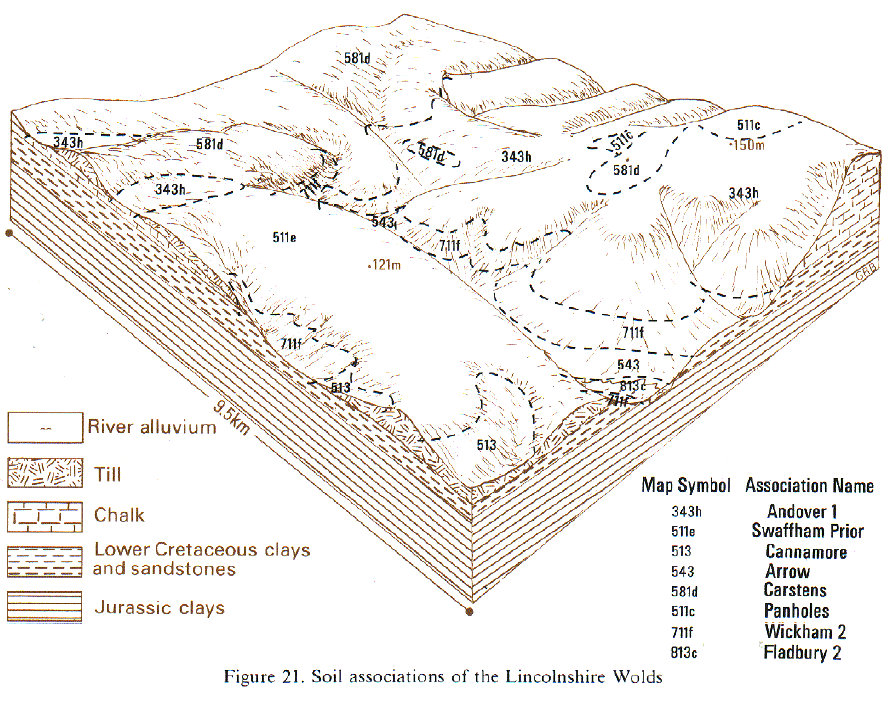
Soil Associations
0511c PANHOLES
Soil and site characteristics
Well drained calcareous fine silty soils over chalk. Associated similar shallow soils and deeper non-calcareous fine silty soils.
Geology
Chalk
Cropping and Land Use
Cereals; some short term grassland, potatoes and field vegetables.
Component soil series
| Subgroup | Series name | Percentage | WRB 2006 link |
|---|---|---|---|
| 5.11 | PANHOLES | 60% | Calcaric Endoleptic Cambisols |
| 3.43 | ANDOVER | 30% | Calcaric Leptosols |
| 5.71 | CHARITY | 10% | Chromic Luvisols |
Covers 241 km2 in England and Wales
Soilscapes Classification
| 5 |
Freely draining lime-rich loamy soils |
0511c PANHOLES
Detailed Description
The Panholes association is found where thin silty drift covers chalk. It consists mainly of well drained stony calcareous soils which are shallow in places, along with occasional flinty non-calcareous soils. The association is extensive on the Yorkshire Wolds where it occurs on gently sloping hill tops between 50 and 240 m O.D. Smaller areas covering 22 km² occur on the Lincolnshire Wolds near Market Rasen. In both districts the highest ground suffers from exposure. The most extensive soils belong to the well drained calcareous fine silty Panholes series. These soils, 30 to 80 cm deep, generally contain many chalk and flint stones and are commonly associated with shallow very stony calcareous fine silty soils belonging to Andover series. Fine silty non-calcareous soils, Charity series), occur locally where they can usually be recognized by their flinty topsoil. Typically in Lincolnshire, Panholes series, typical brown calcareous earths, occurs on relatively level ground. The Andover series, brown rendzinas, is most common on sloping land, particularly on the margins of steeper slopes. The non-calcareous Charity series, typical argillic brown earths, is less predictable in its occurrence but is most common on high ground. Garston soils are similar to Charity soils but rest on chalk at less than 80 cm depth. The Porton series is non-calcareous but clayey at less than 80 cm depth and is usually restricted to the highest land.
Soil Water Regime
With the good natural drainage common to all the soils (Wetness Class I), no artificial drainage is required.
Cropping and Land Use
Although the soils are shallow, or only moderately deep over chalk, most crop roots are able to penetrate the underlying fragmented chalk to extract moisture so droughtiness is less marked than on other soils of similar depth. In a normal year the soils are slightly droughty, most crops being moderately droughty under grass only. Cereals, potatoes and other root crops are widely grown and yield well despite the shallowness of many soils. Oilseed rape has become increasingly popular in recent years as a break crop between cereals. Although the Panholes, Andover and Charity series are easy to work, autumn ploughing is advisable as there are far fewer days in spring suitable for cultivating without structural damage.
On the higher parts of the Wolds conditions are suitable, and have been approved, for seed potato growing. In recent years oilseed rape has become increasingly popular as a break crop between cereals. In areas close to the freezer factories in Hull, vining peas and brussels sprouts are also useful break crops. Grass is included in the crop rotation on most farms.All soils have a good level of natural fertility which is easily maintained with normal fertilizer use. Periodic application of farmyard manure is useful to maintain organic matter levels. Soil acidity may develop in the Charity, Porton and Garston series, and occasionally in the topsoil in the Panholes series. A magnesium-rich lime is very suitable on such soils since they often lack sufficient available magnesium. As most coniferous species grow best in acid soils, the Wolds are not ideal for forestry, although there are a number of small coniferous plantations. Trees grow well in the valleys however and are suitable where land is too steep to cultivate. Beech grows well on the freely drained chalk soils and fine specimens can be seen.
0511c PANHOLES
Distribution Map
 |
Note that the yellow shading represents a buffer to highlight the location of very small areas of the association.
Keys to component soil series
Northern Region
 |
Typical Landscapes
Eastern Region
 |
Northern Region
 |
All information Copyright, Cranfield University © 2025
Citation: To use information from this web resource in your work, please cite this as follows:
Cranfield University 2025. The Soils Guide. Available: www.landis.org.uk. Cranfield University, UK. Last accessed 25/04/2025
